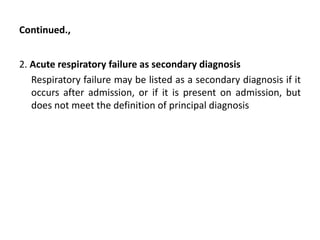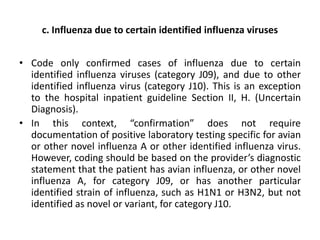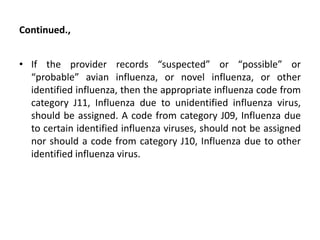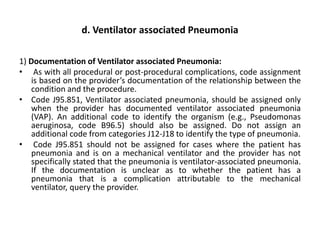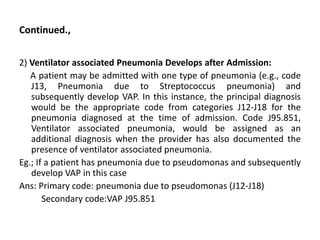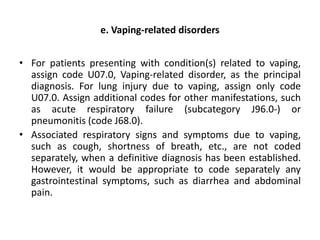Diseases of the Respiratory System (J00-J99),.pptx
- 1. Diseases of the Respiratory System (J00-J99), U07.0 Presented by Guide E.Prabhu Teja Archana Suryawanshi M.Pharm (Q.A) M.Pharm(P.A) Medical Coding Trainer
- 2. CONTENTS a) Chronic Obstructive Pulmonary Disease (COPD) and Asthma b) Acute Respiratory Failure c) Influenza due to certain identified influenza viruses d) Ventilator associated Pneumonia e) Vaping related disorders
- 3. a. Chronic Obstructive Pulmonary Disease (COPD) and Asthma • Chronic Obstructive Pulmonary Disease [COPD] and Asthma Acute exacerbation of chronic obstructive bronchitis and asthma The codes in categories J44 and J45 distinguish between uncomplicated cases and those in acute exacerbation. • An acute exacerbation is a worsening or a decompensation of a chronic condition. An acute exacerbation is not equivalent to an infection superimposed on a chronic condition, though an exacerbation may be triggered by an infection.
- 4. b. Acute Respiratory Failure 1. Acute respiratory failure as principal diagnosis A code from subcategory J96.0, Acute respiratory failure, or subcategory J96.2, Acute and chronic respiratory failure, may be assigned as a principal diagnosis when it is the condition established after study to be chiefly responsible for occasioning the admission to the hospital, and the selection is supported by the Alphabetic Index and Tabular List. However, chapter- specific coding guidelines (such as obstetrics, poisoning, HIV, newborn) that provide sequencing direction take precedence
- 5. Continued., 2. Acute respiratory failure as secondary diagnosis Respiratory failure may be listed as a secondary diagnosis if it occurs after admission, or if it is present on admission, but does not meet the definition of principal diagnosis
- 6. Continued., 3. Sequencing of acute respiratory failure and another acute condition When a patient is admitted with respiratory failure and another acute condition, (e.g., myocardial infarction, cerebrovascular accident, aspiration pneumonia), the principal diagnosis will not be the same in every situation. This applies whether the other acute condition is a respiratory or non-respiratory condition. Selection of the principal diagnosis will be dependent on the circumstances of admission. If both the respiratory failure and the other acute condition are equally responsible for occasioning the admission to the hospital, and there are no chapter- specific sequencing rules, the guideline regarding two or more diagnoses that equally meet the definition for principal diagnosis (Section II, C.) may be applied in these situations. If the documentation is not clear as to whether acute respiratory failure and another condition are equally responsible for occasioning the admission, query the provider for clarification.
- 7. c. Influenza due to certain identified influenza viruses • Code only confirmed cases of influenza due to certain identified influenza viruses (category J09), and due to other identified influenza virus (category J10). This is an exception to the hospital inpatient guideline Section II, H. (Uncertain Diagnosis). • In this context, “confirmation” does not require documentation of positive laboratory testing specific for avian or other novel influenza A or other identified influenza virus. However, coding should be based on the provider’s diagnostic statement that the patient has avian influenza, or other novel influenza A, for category J09, or has another particular identified strain of influenza, such as H1N1 or H3N2, but not identified as novel or variant, for category J10.
- 8. Continued., • If the provider records “suspected” or “possible” or “probable” avian influenza, or novel influenza, or other identified influenza, then the appropriate influenza code from category J11, Influenza due to unidentified influenza virus, should be assigned. A code from category J09, Influenza due to certain identified influenza viruses, should not be assigned nor should a code from category J10, Influenza due to other identified influenza virus.
- 9. d. Ventilator associated Pneumonia 1) Documentation of Ventilator associated Pneumonia: • As with all procedural or post-procedural complications, code assignment is based on the provider’s documentation of the relationship between the condition and the procedure. • Code J95.851, Ventilator associated pneumonia, should be assigned only when the provider has documented ventilator associated pneumonia (VAP). An additional code to identify the organism (e.g., Pseudomonas aeruginosa, code B96.5) should also be assigned. Do not assign an additional code from categories J12-J18 to identify the type of pneumonia. • Code J95.851 should not be assigned for cases where the patient has pneumonia and is on a mechanical ventilator and the provider has not specifically stated that the pneumonia is ventilator-associated pneumonia. If the documentation is unclear as to whether the patient has a pneumonia that is a complication attributable to the mechanical ventilator, query the provider.
- 10. Continued., 2) Ventilator associated Pneumonia Develops after Admission: A patient may be admitted with one type of pneumonia (e.g., code J13, Pneumonia due to Streptococcus pneumonia) and subsequently develop VAP. In this instance, the principal diagnosis would be the appropriate code from categories J12-J18 for the pneumonia diagnosed at the time of admission. Code J95.851, Ventilator associated pneumonia, would be assigned as an additional diagnosis when the provider has also documented the presence of ventilator associated pneumonia. Eg.; If a patient has pneumonia due to pseudomonas and subsequently develop VAP in this case Ans: Primary code: pneumonia due to pseudomonas (J12-J18) Secondary code:VAP J95.851
- 11. e. Vaping-related disorders • For patients presenting with condition(s) related to vaping, assign code U07.0, Vaping-related disorder, as the principal diagnosis. For lung injury due to vaping, assign only code U07.0. Assign additional codes for other manifestations, such as acute respiratory failure (subcategory J96.0-) or pneumonitis (code J68.0). • Associated respiratory signs and symptoms due to vaping, such as cough, shortness of breath, etc., are not coded separately, when a definitive diagnosis has been established. However, it would be appropriate to code separately any gastrointestinal symptoms, such as diarrhea and abdominal pain.
- 12. THANK YOU
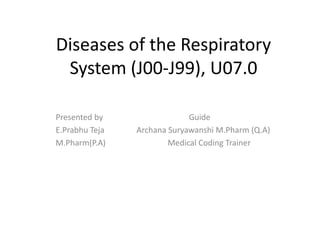

![a. Chronic Obstructive Pulmonary Disease (COPD) and Asthma
• Chronic Obstructive Pulmonary Disease [COPD] and Asthma
Acute exacerbation of chronic obstructive bronchitis and
asthma The codes in categories J44 and J45 distinguish
between uncomplicated cases and those in acute
exacerbation.
• An acute exacerbation is a worsening or a decompensation of
a chronic condition. An acute exacerbation is not equivalent
to an infection superimposed on a chronic condition, though
an exacerbation may be triggered by an infection.](https://image.slidesharecdn.com/mcseminartopicdiseasesoftherespiratorysystemj00-j99-240323100314-7cd0852d/85/Diseases-of-the-Respiratory-System-J00-J99-pptx-3-320.jpg)

